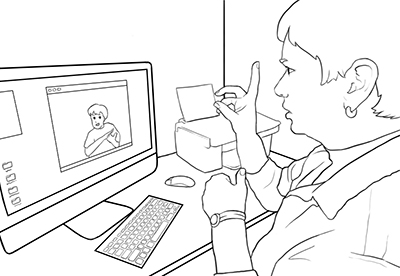Let's Impress! How to Present Yourself Well Online

How students can present themselves well in online courses and meetings
As a result of the 2020 pandemic, millions of students were suddenly learning online and thinking about how to present themselves well in classes and other meetings. In person, there are many ways to impress and interact with instructors; however, when online, the opportunities become more limited and focused.
During the online DO-IT Scholars summer program in 2020, more than 20 students with disabilities in high school and college brainstormed ideas regarding how to present themselves as serious students in online courses. You may find their ideas useful!
Ask for reasonable accommodations related to your disability. Some examples are listed here:
- A person with limited speech could ask to communicate through the chat feature or other text-based interface.
- Someone with high anxiety could ask to have their camera off as needed.
- A student with limited sight can remind the group to describe images, ask for materials in advance, highlight a particular speaker, and ask to have their camera off if their eyes are really close to the screen.
- Someone with limited hearing can arrange for real-time captions or a sign language interpreter.
Demonstrate your respect and engagement in the course.
- Arrive on time.
- Sit up straight and use body positions that show you are alert and attentive.
- Pay attention and engage. When possible, use active listening skills such as nodding or smiling in reaction to something said.
- Do not eat unless the meeting is informal or the instructor gives approval to do so. If eating is allowed, choose something that is easily manageable, not too loud, and permits you to speak up when necessary.
- Always be ready with materials for taking notes or other class activities.
- Do not multitask during the meeting. Avoid using your phone and be sure to give the instructor your full attention.
- Actively engage in the class but do not dominate conversations or chat interactions.
- Pay attention to how the instructor wants you to engage (e.g., speak up at any time, raise your hand to speak, post questions and comments in chat) and follow their instructions.
- Be kind, respectful, and considerate of others.
Ensure a high-quality visual appearance.
- Dress appropriately; use your instructor as a guide for how formal or informal your attire should be. Solid colors often project well. Even though you may not intend for the bottom half of your body to show, wear an outfit where you will not be embarrassed if you need to stand up or move around.
- Choose an uncluttered background that is appropriate for the occasion. If you use a virtual background, choose a non-distracting one that minimizes distortions when you move around. Be aware that virtual backgrounds can be very distracting to others.
- Minimize distracting movements (e.g., spinning in your chair, fiddling with hair, active pets, spinning ceiling fan, etc.) as much as possible. If movement is necessary, turn off your video as appropriate.
- Position your computer so that the camera is at eye level or slightly higher to make “virtual eye contact” with other participants. Position your face a little below the top of the screen and leave enough room at the bottom for your name. Position yourself a moderate distance from the camera, not too close or too far away. Make sure that your whole face is visible.
- For your screen image, include your name and possibly preferred pronouns rather than an email address. If you need to or are asked to turn off your camera, use a profile photo of yourself that projects an image of a serious student.
- Facing diffused natural light is best. Avoid using a light source from behind you, which can result in too much shadow on your face. Try different lamps and lights until you find the best lighting for your setup. Test your lighting in advance by showing your camera view on-screen or video chatting with a friend.
Consider these tips to ensure high-quality audio.
- Consider using an external microphone to improve the quality of the sound you project.
- Consider using a headset to help minimize distractions and focus your sound.
- Speak clearly, but do not yell.
- Mute your microphone when not speaking, especially with larger groups.
- Participate in a quiet space and minimize distracting sounds in your environment (phone ringing, dog barking, people talking).
- If a distraction does occur, don’t add to the commotion of noisy sounds (e.g., apologizing for a child talking); instead, correct the situation as quickly and quietly as possible (e.g., mute your microphone).
About DO-IT
DO-IT (Disabilities, Opportunities, Internetworking, and Technology) serves to increase the successful participation of individuals with disabilities in challenging academic programs and careers, such as those in science, engineering, mathematics, and technology. Primary funding for DO-IT is provided by the National Science Foundation, the State of Washington, and the U.S. Department of Education.
For further information, to be placed on the DO- IT mailing list, request materials in an alternate format, or to make comments or suggestions about DO-IT publications or web pages, contact:
DO-IT
University of Washington
Box 354842
Seattle, WA 98195-4842
doit@uw.edu
www.uw.edu/doit
206-685-DOIT (3648) (voice/TTY)
888-972-DOIT (3648) (toll free voice/TTY)
509-328-9331 (voice/TTY) Spokane
206-221-4171 (fax)
Founder and Director: Sheryl Burgstahler, Ph.D.
Copyright © 2021 University of Washington.
Permission is granted to copy these materials for educational, noncommercial purposes provided the source is acknowledged.